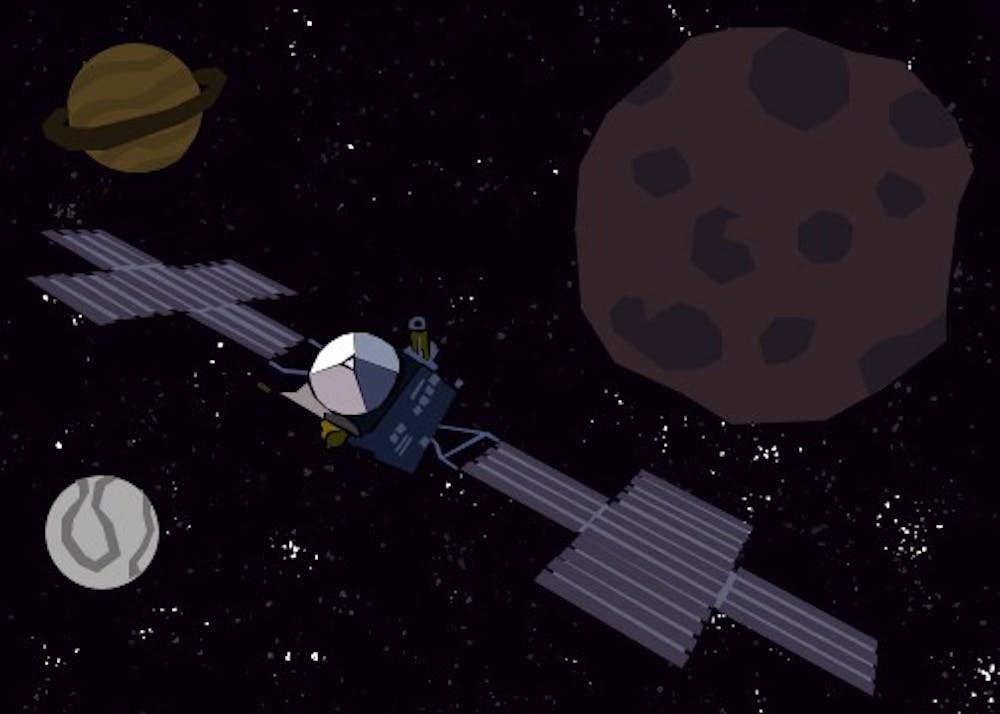The Psyche spacecraft, the vessel of an ASU-led mission to a giant, mostly metal asteroid, passed a series of critical tests over several months at NASA's Jet Propulsion Laboratory, putting the spacecraft one step closer to launch.
The six-phase Mission to Psyche is in its fourth phase where the spacecraft and its instruments undergo assembly and tests, the most recent of which simulated the conditions the spacecraft will face during launch and its travels into deep space.
"Building and launching a spacecraft to explore distant places in the Solar System is never easy," said Meenakshi Wadhwa, director and professor at the School of Earth and Space Exploration, in an emailed statement. "On top of this, of course, there have been additional difficulties imposed due to the ongoing pandemic. Nevertheless, the Psyche team has worked together successfully to overcome these challenges."
The Mission to Psyche will be the first to explore the metal-rich asteroid that is as old as our solar system and is roughly the size of Massachusetts, located in the asteroid belt of our solar system.
Scientists believe studying the Psyche asteroid could finally reveal how Earth’s core formed.
The mission is an $850 million collaboration between the University, government and others that has been in the works since 2017.
Because of the long journey the spacecraft will make, environmental testing was necessary to see if the spacecraft can handle the harsh nature of spaceflight and the unforgiving conditions of space.
Part of the testing involved putting the spacecraft into a vacuum chamber to simulate airless space conditions, said Jim Bell, deputy principal investigator of the Mission to Psyche and professor at ASU.
"You put the whole spacecraft in (the vacuum chamber), and you get it cold, and you kick all the air out and turn it into a vacuum, and you say 'OK? Cameras, OK? Spacecraft, this is where you’re gonna live, can you work in this environment?'" Bell said.
Through the test and many others, the Psyche spacecraft proved it could last in space.
Over the months-long testing period at JPL in California, the Psyche spacecraft went through electromagnetic testing – the process of sending electric currents and magnetic fields into an object – to see if the spacecraft’s electrical components worked in tandem; and dynamics testing – shock, vibration, and acoustic tests – to see if the spacecraft could handle the sometimes sudden and jolting movements of spaceflight.
"Basically, it’s simulating launch and the violent vibration and acoustic energy of a rocket launch," Bell said. "When you see a rocket launch from a mile and a half or two miles away, which is as close as NASA lets people get to rockets launching, it's super loud and you can feel it. ... so imagine what's happening to your sensitive instruments sitting on top of that rocket."
One of those instruments is the ASU developed Imager, a device that will provide images of Psyche's surface to determine what the asteroid is made of and what it looks like.
The Imager can see in the near-infrared, allowing scientists to gather data based on sunlight reflected off of the asteroid, Bell said.
One of the big questions surrounding this massive asteroid is how it came to be. Scientists think Psyche is either the exposed core of a never-to-be planet or a bunch of metal brought together by gravity.
No matter how it was created, the Psyche asteroid might have a unique shape because it is made of mostly metal. Some scientists are curious about how Psyche's makeup will affect its geographical features.
"We are going to a world made out of metal to try and understand what geological features look like when they are made out of metal (and) how are they different from a world that’\'s made out of rock or ice," said David Williams, a co-investigator of NASA's Mission to Psyche and research professor at SESE, who will take the data from the mission to create a digital map of the asteroid’s surface.
Psyche will launch from Cape Canaveral in August, then it will reach Psyche in 2026 and spend almost two years collecting data.
Now that launch is around the corner, Bell said he is excited and a little nervous, but he knows it will be a relief once the Psyche spacecraft is safely in space.
"It's a good feeling to pass your environmental tests," Bell said. "Obviously, a rocket launch is not just a routine; there's a lot that has to be prepared for, a lot to be nervous about. I think we're all going to be most happy ... when it's just safely out in space."
Reach the reporter at kryback1@asu.edu and follow @KadenRyback on Twitter.
Like The State Press on Facebook and follow @statepress on Twitter.

Kaden is a reporter for the Biztech desk, focusing on student run business, people profiles and research papers. During his time at The State Press, Kaden's biggest piece was about ASU's history with NASA. He's a sophomore majoring in Journalism and Mass Communication.




